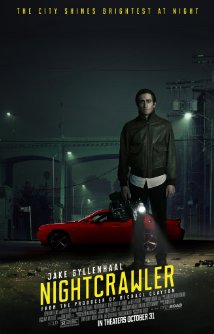“Nightcrawler” definitely won the lottery in terms of psychological thrillers. But first, it needed to make the money to buy a ticket. Psychological thrillers are supposed to mess with your mind, test your limits and maybe scare you a little bit. If you walk away from one feeling confused, mad or downright disturbed, then the film has done its job perfectly. Dan Gilroy‘s directorial debut accomplished this perfectly. “Nightcrawler” follows anti-hero Louis Bloom, played by Jake Gyllenhaal, a sociopath who films crime scenes and sells the footage to a TV news station. Bloom has no limits when it comes to expanding his news production service.

If you are tired of films with a protagonist who has perfect morals, and a happy tearjerker ending, you will find solace in “Nightcrawler.” Providing no backstory, save for the teaser trailer, Gyllenhaal’s character begins as a mildly creepy guy with no direction, but is expertly developed into a far deeper and more evil character. Gyllenhaal is probably the best psychological thriller actor out there right now, with credits to amazing films like “Donnie Darko,” “Zodiac,” “Prisoners” and “Enemy.” His boyish face and skill at portraying deeply conflicted characters makes him invaluable for the genre. The boyish complexion was lost for Gyllenhaal in this film though, as he lost over 20 pounds for the role to appear as even more of a cold, calculated and desperate man. “Nightcrawler” is an extremely artistic film. The screenplay, cinematography, score and art direction were all executed in the best way possible. Screenplay All good films have an overarching theme to their stories. Dan Gilroy, “Nightcrawler’s” writer and director, chose themes of conflict and duality. For example, one character in “Nightcrawler” is in many ways the same as Louis Bloom, the protagonist. Bloom, being internally conflicted, hates seeing himself in another person, and proceeds to look at himself in a mirror in the very next scene before breaking it. The dialogue of Bloom’s character is naturally chilling, funny and even foreshadowing at times. Making an interesting and believable character is one of a screenwriters’ toughest jobs, and Gilroy does it extremely well. Cinematography Oscar-winning cinematographer Robert Elswit had the challenge of filming the character in “Nightcrawler.” The film followed realist filming rules, meaning that every shot was done where a camera could realistically be placed (so no helicopter shots, crane shots or moving the camera through some place people could never really go). The resulting effect of this technique is a more immersive feeling in Louis Bloom’s world; one feels as thought they are carrying a camera in their hands right behind him. Additionally, instead of filming Bloom’s point of view, we are shown what he sees through the viewfinder screen of his own camera, just another small technique that adds to the whole film’s attention to detail. Score James Newton Howard, an eight-time Oscar nominated composer, is one of those names in movie music that is known by everybody in the business and seems to do music for everything. He is responsible for the score of the Dark Knight films, the Hunger Games films, some of Dreamworks Animation‘s greatest movies and some of the most popular fantasy films in recent years. His work in “Nightcrawler” perfectly reflects the uneasiness of the film itself. The soundtrack feels like a slowed down, calmer and eerie horror film soundtrack. Art direction Art direction is one of the most under appreciated aspects of filmmaking. Since movies stopped being made in black and white, color has been one of the most crucial aspects. Naaman Marshall, the art director for the Dark Knight films, molded the universe of “Nightcrawler” in a distinctive style. A film’s color palette and visual style help set the mood and reflect the themes of the story itself. For example, almost every scene in “Nightcrawler” shows distinct reds and yellows, whether it be a neon sign, a streetlight, a car, a reflection in Bloom’s sunglasses or lens, clothing or the lights of a radio. Yellow, representative of happiness and joy, combined with red, representative of anger and blood, perfectly reflect the sociopathic, conflicted and disturbed nature of the protagonist. Don’t expect too much award buzz over this film simply for its lack of traditional drama, but it is still a must see for the post-Halloween season. Collegian A&E Film Beat Writer Morgan Smith can be reached at entertainment@collegian.com or on Twitter @MDSFilms.




